《传播学导论》课程教学资源(阅读材料)Communication Model
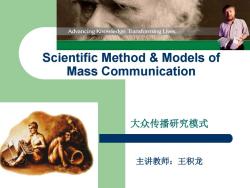
Advancing Knowledge.Transforming Lives. Scientific Method Models of Mass Communication 大众传播研究模式 主讲教师:王积龙
大众传播研究模式 Scientific Method & Models of Mass Communication 主讲教师:王积龙
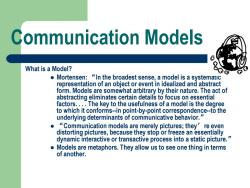
Communication Models What is a Model? 6的 Mortensen:"In the broadest sense,a model is a systematic representation of an object or event in idealized and abstract form.Models are somewhat arbitrary by their nature.The act of abstracting eliminates certain details to focus on essential factors....The key to the usefulness of a model is the degree to which it conforms--in point-by-point correspondence--to the underlying determinants of communicative behavior. ."Communication models are merely pictures;they're even distorting pictures,because they stop or freeze an essentially dynamic interactive or transactive process into a static picture." Models are metaphors.They allow us to see one thing in terms of another
Communication Models What is a Model? Mortensen: “In the broadest sense, a model is a systematic representation of an object or event in idealized and abstract form. Models are somewhat arbitrary by their nature. The act of abstracting eliminates certain details to focus on essential factors. . . . The key to the usefulness of a model is the degree to which it conforms--in point-by-point correspondence--to the underlying determinants of communicative behavior.” “Communication models are merely pictures; they’re even distorting pictures, because they stop or freeze an essentially dynamic interactive or transactive process into a static picture.” Models are metaphors. They allow us to see one thing in terms of another
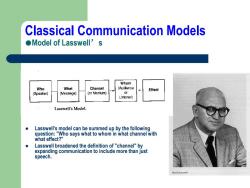
Classical Communication Models ●Model of Lasswell's Whom Who What Channel (Audience = Effect (Speaker) (Me88age】 (or Medium) r Listener) Lasswell's Model. Lasswell's model can be summed up by the following question:"Who says what to whom in what channel with what effect?" Lasswell broadened the definition of"channel"by expanding communication to include more than just speech
Classical Communication Models ●Model of Lasswell’s Lasswell's model can be summed up by the following question: "Who says what to whom in what channel with what effect?" Lasswell broadened the definition of "channel" by expanding communication to include more than just speech

Communication Models The Advantages of Models Mortensen: "A good model is useful,then,in providing both general perspective and particular vantage points from which to ask questions and to interpret the raw stuff of observation.The more complex the subject matter-the more amorphous and elusive the natural boundaries-the greater are the potential rewards of model building. They should clarify complexity. Models also clarify the structure of complex events.They do this,as Chapanis(1961) noted,by reducing complexity to simpler,more familiar terms...Thus,the aim of a model is not to ignore complexity or to explain it away,but rather to give it order and coherence. ● They should lead us to new discoveries-most important,according to Mortensen. ● At another level models have heuristic value;that is,they provide new ways to conceive of hypothetical ideas and relationships.This may well be their most important function.With the aid of a good model,suddenly we are jarred from conventional modes of thought.... ldeally,any model,even when studied casually,should offer new insights and culminate in what can only be described as an“Ahal” experience
Communication Models The Advantages of Models Mortensen: “A good model is useful, then, in providing both general perspective and particular vantage points from which to ask questions and to interpret the raw stuff of observation. The more complex the subject matter—the more amorphous and elusive the natural boundaries—the greater are the potential rewards of model building.” They should clarify complexity. Models also clarify the structure of complex events. They do this, as Chapanis (1961) noted, by reducing complexity to simpler, more familiar terms. . . Thus, the aim of a model is not to ignore complexity or to explain it away, but rather to give it order and coherence. They should lead us to new discoveries-most important, according to Mortensen. At another level models have heuristic value; that is, they provide new ways to conceive of hypothetical ideas and relationships. This may well be their most important function. With the aid of a good model, suddenly we are jarred from conventional modes of thought. . . . Ideally, any model, even when studied casually, should offer new insights and culminate in what can only be described as an “Aha!” experience
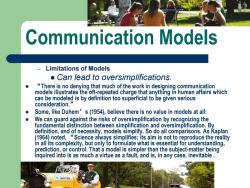
Communication Models Limitations of Models Can lead to oversimplifications ● "There is no denying that much of the work in designing communication models illustrates the oft-repeated charge that anything in human affairs which can be modeled is by definition too superficial to be given serious consideration.” ● Some,like Duhem's (1954),believe there is no value in models at all: We can guard against the risks of oversimplification by recognizing the fundamental distinction between simplification and oversimplification.By definition,and of necessity,models simplify.So do all comparisons.As Kaplan (1964)noted,"Science always simplifies;its aim is not to reproduce the reality in all its complexity,but only to formulate what is essential for understanding, prediction,or control.That a model is simpler than the subject-matter being inquired into is as much a virtue as a fault,and is,in any case,inevitable
Communication Models – Limitations of Models Can lead to oversimplifications. “There is no denying that much of the work in designing communication models illustrates the oft-repeated charge that anything in human affairs which can be modeled is by definition too superficial to be given serious consideration.” Some, like Duhem’s (1954), believe there is no value in models at all: We can guard against the risks of oversimplification by recognizing the fundamental distinction between simplification and oversimplification. By definition, and of necessity, models simplify. So do all comparisons. As Kaplan (1964) noted, “Science always simplifies; its aim is not to reproduce the reality in all its complexity, but only to formulate what is essential for understanding, prediction, or control. That a model is simpler than the subject-matter being inquired into is as much a virtue as a fault, and is, in any case, inevitable
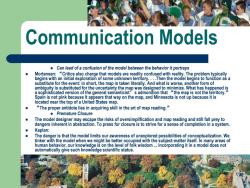
Communication Models ● Can lead of a confusion of the model between the behavior it portrays Mortensen:"Critics also charge that models are readily confused with reality.The problem typically begins with an initial exploration of some unknown territory....Then the model begins to function as a substitute for the event:in short,the map is taken literally.And what is worse,another form of ambiguity is substituted for the uncertainty the map was designed to minimize.What has happened is a sophisticated version of the general semanticist's admonition that "the map is not the territory. Spain is not pink because it appears that way on the map,and Minnesota is not up because it is located near the top of a United States map. "The proper antidote lies in acquiring skill in the art of map reading." ●Premature Closure The model designer may escape the risks of oversimplification and map reading and still fall prey to dangers inherent in abstraction.To press for closure is to strive for a sense of completion in a system. Kaplan: The danger is that the model limits our awareness of unexplored possibilities of conceptualization.We tinker with the model when we might be better occupied with the subject-matter itself.In many areas of human behavior,our knowledge is on the level of folk wisdom...incorporating it in a model does not automatically give such knowledge scientific status
Communication Models Can lead of a confusion of the model between the behavior it portrays Mortensen: “Critics also charge that models are readily confused with reality. The problem typically begins with an initial exploration of some unknown territory. . . .Then the model begins to function as a substitute for the event: in short, the map is taken literally. And what is worse, another form of ambiguity is substituted for the uncertainty the map was designed to minimize. What has happened is a sophisticated version of the general semanticist’s admonition that “the map is not the territory.” Spain is not pink because it appears that way on the map, and Minnesota is not up because it is located near the top of a United States map. “The proper antidote lies in acquiring skill in the art of map reading.” Premature Closure The model designer may escape the risks of oversimplification and map reading and still fall prey to dangers inherent in abstraction. To press for closure is to strive for a sense of completion in a system. Kaplan: The danger is that the model limits our awareness of unexplored possibilities of conceptualization. We tinker with the model when we might be better occupied with the subject-matter itself. In many areas of human behavior, our knowledge is on the level of folk wisdom ... incorporating it in a model does not automatically give such knowledge scientific status
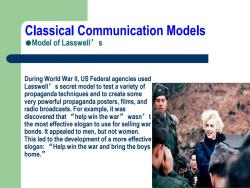
Classical Communication Models ●Model of Lasswell's During World War ll,US Federal agencies used Lasswell's secret model to test a variety of propaganda techniques and to create some very powerful propaganda posters,films,and radio broadcasts.For example,it was discovered that“help win the war'”wasn't the most effective slogan to use for selling war bonds.It appealed to men,but not women. This led to the development of a more effective slogan:"Help win the war and bring the boys home.为
Classical Communication Models ●Model of Lasswell’s During World War II, US Federal agencies used Lasswell’s secret model to test a variety of propaganda techniques and to create some very powerful propaganda posters, films, and radio broadcasts. For example, it was discovered that “help win the war” wasn’t the most effective slogan to use for selling war bonds. It appealed to men, but not women. This led to the development of a more effective slogan: “Help win the war and bring the boys home
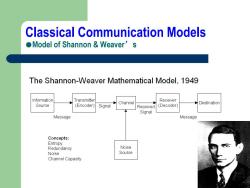
Classical Communication Models Model of Shannon Weaver's The Shannon-Weaver Mathematical Model,1949 Information Transmitte Receiver Channel Destination Source (Encoder Signal Received (Decoder) Signal Message Message Concepts: Entropy Redundancy Noise Noise Source Channel Capacity
Classical Communication Models ●Model of Shannon & Weaver’s
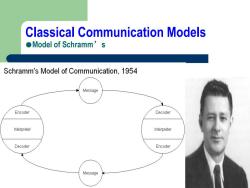
Classical Communication Models ●Model of Schramm's Schramm's Model of Communication,1954 Message Encoder Decoder Interpreter Interpreter Decoder Encoder Message
Classical Communication Models ●Model of Schramm’s
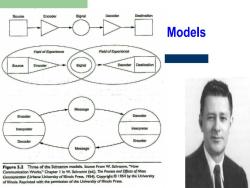
Source Encoder Signal Decoder Destination Models Fleld of Experience Field of Experience Source Encoder Signal Decoder Destination Message Encoder Decoder Interpreter Interpreter Decoder Encoder Message Figure 3.2 Three of the Schramm models.Source:From W.Schramm,"How Communication Works,"Chapter I in W.Schramm(ed.).The Process and Effects of Mass Communication (Urbana:University of llinois Press,1954).Copyright1954 by the University of lllinois.Reprinted with the permission of the University of lllinois Press
Classical Communication Models ●Model of Schramm’s
按次数下载不扣除下载券;
注册用户24小时内重复下载只扣除一次;
顺序:VIP每日次数-->可用次数-->下载券;
- 《传播学导论》课程教学资源(阅读材料)Cognitive Consistency.pdf
- 《传播学导论》课程教学资源(阅读材料)Analysis of Propaganda Decoding & Its Effects.pdf
- 《新闻学概论》课程教学资源(学习笔记)新闻学概论课堂笔记.pdf
- 《新闻采访》课程教学资源(文献资料)异地采访经验谈.doc
- 《新闻采访》课程教学资源(文献资料)现场采访经验.doc
- 《新闻采访》课程教学资源(文献资料)国际足球赛事采访经验谈.doc
- 《新闻采访》课程教学资源(文献资料)采访写作课的新理念与新实践.pdf
- 《新闻采访》课程教学资源(文献资料)简论典型人物的采访技巧.pdf
- 《新闻采访》课程教学资源(文献资料)论电视新闻采访的真实性、简论典型人物的采访技巧.pdf
- 《新闻采访》课程教学资源(文献资料)谈电视新闻采访中的女性特质.pdf
- 《新闻采访》课程教学资源(文献资料)试论新时期我国付费采访的表现形式及其影响.pdf
- 《新闻采访》课程教学资源(文献资料)越看越糊涂的报纸新闻——谈记者的采访要领和利用传媒特许权.pdf
- 《新闻采访》课程教学资源(文献资料)我国隐性采访的法律规范.pdf
- 《新闻采访》课程教学资源(文献资料)几种热门的专业新闻采访.doc
- 《新闻采访》课程教学资源(文献资料)专题三 新闻事件类之经济类采访.doc
- 《新闻采访》课程教学资源(文献资料)专题二 新闻事件类之时政类采访.doc
- 《新闻采访》课程教学资源(文献资料)专题一 人物采访报道.doc
- 《新闻采访》课程教学资源(文献资料)电视新闻现场采访的应对.pdf
- 南京农业大学:《广告学》课程教学大纲.pdf
- 南京农业大学:《电影发展简史》课程教学大纲.pdf
- 《传播学导论》课程教学资源(阅读材料)Effects of Media Communication.pdf
- 《传播学导论》课程教学资源(阅读材料)From Marshall Mcluhan to postmodernism.pdf
- 《传播学导论》课程教学资源(阅读材料)Health Communication.pdf
- 《传播学导论》课程教学资源(阅读材料)Mass Media and Interpersonal Communication.pdf
- 《传播学导论》课程教学资源(阅读材料)Mass Media Effects and Uses.pdf
- 《传播学导论》课程教学资源(阅读材料)Measurement of Readability.pdf
- 《传播学导论》课程教学资源(阅读材料)Perception and Language Issues in the Mass Media.pdf
- 《传播学导论》课程教学资源(阅读材料)The Knowledge-Gap Hypothesis.pdf
- 《传播学导论》课程教学资源(阅读材料)Theory of Persuasion.pdf
- 《传播学导论》课程教学资源(阅读材料)Uses and Gratification Approach.pdf
- 苏州大学:《电视摄像基础》课程教学资源(课件讲稿)第一章 摄像机(1节)摄像机发展史.pdf
- 苏州大学:《电视摄像基础》课程教学资源(课件讲稿)第一章 摄像机(2节)摄像机的结构(A).pdf
- 苏州大学:《电视摄像基础》课程教学资源(课件讲稿)第一章 摄像机(2节)摄像机的结构(B).pdf
- 苏州大学:《电视摄像基础》课程教学资源(课件讲稿)第一章 摄像机(3节)节摄像机的调整与使用.pdf
- 苏州大学:《电视摄像基础》课程教学资源(课件讲稿)第一章 摄像机(4节)摄像机持机方式.pdf
- 苏州大学:《电视摄像基础》课程教学资源(课件讲稿)第一章 摄像机(5节)摄像机的分类.pdf
- 苏州大学:《电视摄像基础》课程教学资源(课件讲稿)第二章 电视画面.pdf
- 苏州大学:《电视摄像基础》课程教学资源(课件讲稿)第三章 电视画面构图.pdf
- 苏州大学:《电视摄像基础》课程教学资源(课件讲稿)第五章 固定画面.pdf
- 苏州大学:《电视摄像基础》课程教学资源(课件讲稿)第六章 电视场面调度.pdf
